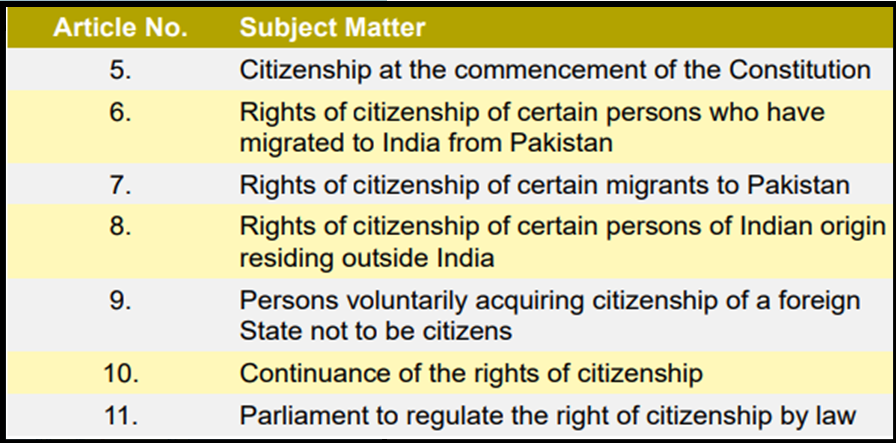CAA:A FADING STORY
Syllabus:
GS 2 :
- Indian Constitution—Historical Underpinnings, Evolution, Features, Amendments, Significant Provisions and Basic Structure.
- Government Policies and Interventions.
| What is the Citizenship Amendment Act, 2019?
● Amends the Citizenship Act, 1955 to grant citizenship to religious minorities (Hindu, Sikh, Buddhist, Jain, Parsi, Christian) from Pakistan, Bangladesh, and Afghanistan. ● Eligible migrants who entered India |
Why in the news?
- CAA has been implemented in India but CAA’s limited impact, challenges in Assam, external criticism, and shifting political landscape spark debates about its effectiveness.
Source : slideserve
| on or before December 31, 2014, and faced religious persecution in their home countries can apply for accelerated citizenship.
● Exempts eligible migrants from criminal proceedings under the Foreigners Act, 1946, and the Passport Act, 1920 |
About Failure to Fulfil Immediate Purpose:
- The CAA’s immediate impact was overshadowed by other events, such as protests and political controversies, diverting attention from its intended objectives.
- The law primarily affected Assam due to its history of anti-illegal immigration movements, but its effectiveness was limited.
About Impact of CAA in India:
- The CAA’s practical impact is limited, with Assam being the only state significantly affected due to historical context and anti-immigration
- Existing laws could have accommodated potential beneficiaries, rendering the CAA unnecessary.
- The CAA primarily aimed to benefit Hindus, Sikhs, Christians, and Buddhists from Pakistan and Bangladesh, estimated at around 20 million.
- However, challenges in defining beneficiaries and delays in implementation raised questions about the law’s effectiveness.
About Rules Issued by the Government Concerning the CAA:
- Historical Context:
- Amendments to Citizenship Rules in 2004 and notifications in 2014, 2015, 2016, and 2018 addressed refugee issues.
- CAA Rules 2024:
- Application process under Section 6B of Citizenship Act, 1955.
- Requirements include proving country of origin, religion, entry date into India, and knowledge of Indian language.
- Proof of Country of Origin:
- Relaxed requirements permit various documents like birth certificates, identity papers, land records, , proving citizenship of specified countries.
- Date of Entry into India:
- Acceptable documents include visas, residential permits, census slips, Aadhaar cards, , to establish entry into India.
- Mechanism for Implementation:
- Processing tasks assigned to Postal department and Census officials by the Ministry of Home Affairs.
- Background checks conducted by Central security agencies like the Intelligence Bureau.
- District-level Committees:
- Headed by Superintendent of the Department of Post, sift through applications.
- Invitee from District Collector’s office..
Challenges in Implementation of the Rules of CAA :
- Delays in implementing the CAA contributed to its diminishing relevance.
- The law’s application cut-off date of December 31, 2014, limited its scope and excluded potential beneficiaries who arrived after this date.
- Ongoing debates in courts and public forums question the constitutionality of defining citizenship based on religion.
- The outcome of these legal battles remains uncertain, with potential implications for future policies and governance.
Understanding the Revival of the CAA:
- The fate of the CAA hinges on several factors, including renewed discussions on the NRC and potential amendments to the law.
- The law’s revival depends on political will and public sentiment, with implications for future elections and governance strategies.
Concerns Related to CAA 2019:
- Constitutional Challenge: Critics argue CAA violates Article 14 of the Indian Constitution, prohibiting religious discrimination in citizenship.
- Potential Disenfranchisement: Linked to NRC, CAA may exclude citizens lacking documentation, as seen in Assam NRC where 19.06 lakh people were left out.
- Impact on Assam Accord: CAA’s differing citizenship timeline may clash with Assam Accord’s residency criteria, causing legal and political complexities.
- Secularism Concerns: Focus on religion for citizenship eligibility undermines secular principles, potentially fueling communal tensions.
- Exclusion of Some Communities: Exclusion of certain persecuted religious groups from CAA raises concerns about fairness and inclusivity.
Way Forward:
(Addressing Concerns Related CAA, 2019)
- Inclusive Refugee Policy:
- Develop a refugee policy aligned with international standards, such as the UN Refugee Convention, ensuring non-discrimination based on religion, ethnicity, or other arbitrary factors.
- Documentation Assistance:
- Implement measures to assist marginalised communities in obtaining necessary documentation to prove their citizenship status.
- Provide support services and resources to help individuals navigate the citizenship verification process, reducing the risk of statelessness.
- Stakeholder Engagement and Dialogue:
- Facilitate meaningful dialogue and consultation with civil society organisations, religious leaders, and communities affected by the CAA to address grievances and concerns.
- Foster an environment for open discussion and constructive engagement to find mutually acceptable solutions.
- International Engagement:
- Engage with neighbouring countries, particularly Pakistan, Afghanistan, and Bangladesh, to address concerns related to religious persecution and human rights violations.
- Work towards regional cooperation and diplomatic initiatives aimed at promoting religious freedom and tolerance in the region.
- Educational and Awareness Campaigns:
- Conduct educational and awareness campaigns to disseminate accurate information about citizenship laws and dispel misinformation or misconceptions.
- Promote public understanding of the principles of equality, secularism, and inclusivity enshrined in the Indian Constitution to foster a more inclusive and tolerant society.
Conclusion
The CAA’s significance lies in its implications for specific regions like Assam rather than its nationwide impact. Its effectiveness and legacy will depend on how future events unfold, including potential amendments or legal challenges. The CAA’s trajectory reflects its complex and evolving nature, influenced by political, legal, and social factors. While it initially aimed to address specific concerns, challenges in implementation and public perception have cast doubts on its efficacy and relevance.
Source:
https://www.business-standard.com/opinion/columns/caa-a-fading-story-124031501170_1.html
Mains Practice Question:
Critically analyze the evolution and impact of the Citizenship Amendment Act (CAA), 2019, on India’s constitutional framework, government policies, and socio-political landscape, with a focus on its implementation challenges and implications.”





